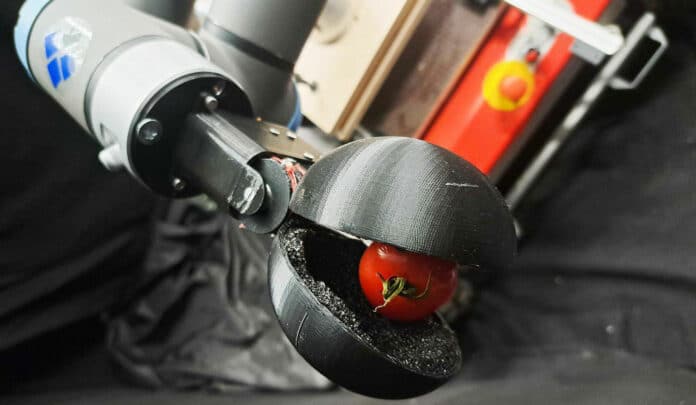The future of robotics is looking brighter than ever with the emergence of large language models (LLMs) like Chat-GPT. These powerful tools have the potential to completely revolutionize the way that robots operate, making them more intelligent, more efficient, and more capable of performing complex tasks.
Now, researchers from the Delft University of Technology in the Netherlands and the Swiss Federal Institute of Technology (EPFL) have used the popular large language model Chat-GPT-3 to develop a robotic gripper for harvesting tomatoes in a first demonstration of the artificial intelligence tool’s potential for collaborating with humans on robot design.
Based on their experience, the researchers describe opportunities and risks of applying artificial intelligence (AI) tools to robotics, which they argue “could change the way we design robots while enriching and simplifying the process.”
“Even though Chat-GPT is a language model, and its code generation is text-based, it provided significant insights and intuition for physical design and showed great potential as a sounding board to stimulate human creativity,” says Josie Hughes, head of the Computational Robot Design & Fabrication Lab in the School of Engineering, EPFL.
In the first phase, the researchers and LLM engaged in an ‘ideation’ discussion to define their robot’s purpose, design parameters, and specifications. A second phase was devoted to realizing the robot in the real world, which includes developing the code generated by the LLM-generated code, fabricating the device, and troubleshooting its functioning.
The researchers started at a high conceptual level, conversing with the LLM on future challenges to humanity and identifying robotic crop harvesting as a solution to the challenge of global food supply. Using the LLM’s access to global data sourced from academic publications, technical manuals, books, and media, the researcher provides the most probable answer to prompts such as “What features should a robot harvester have?”
Once a basic robotic format was identified, the researchers could move on to design specifics, including materials and computer code for controlling the device.
“While computation has been largely used to assist engineers with technical implementation, for the first time, an AI system can ideate new systems, thus automating high-level cognitive tasks. This could involve a shift of human roles to more technical ones,” Cosimo Della Santina of TU Delft says.
In addition to assigning Chat-GPT the role of ‘inventor,’ the researchers highlight other benefits of human-LLM collaboration. “Collaborative research” uses artificial intelligence to support researchers’ skills by contributing wide-ranging knowledge beyond their own fields. AI can act as a “funnel” to help improve the design process and provide technical input, with humans retaining creative control.
As there are logical and ethical risks associated with each collaboration mode, the researchers caution that the role of LLMs must be carefully evaluated going forward.
“In our study, Chat-GPT identified tomatoes as the crop ‘most worth’ pursuing a robotic harvester. However, this may be biased towards crops that are more covered in literature, as opposed to those where there is truly a real need. When decisions are made outside the scope of knowledge of the engineer, this can lead to significant ethical, engineering, or factual errors,” Hughes says.
Despite these cautions, Hughes and her team conclude, based on their experience, that LLMs have great potential to be a force for good if well managed: “The robotics community must therefore identify how to leverage these powerful tools to accelerate the advancement of robots in an ethical, sustainable, and socially empowering way.”
Journal reference:
- Francesco Stella, Cosimo Della Santina and Josie Hughes. How can LLMs transform the robotic design process? Nature Machine Intelligence, 2023; DOI: 10.1038/s42256-023-00669-7
